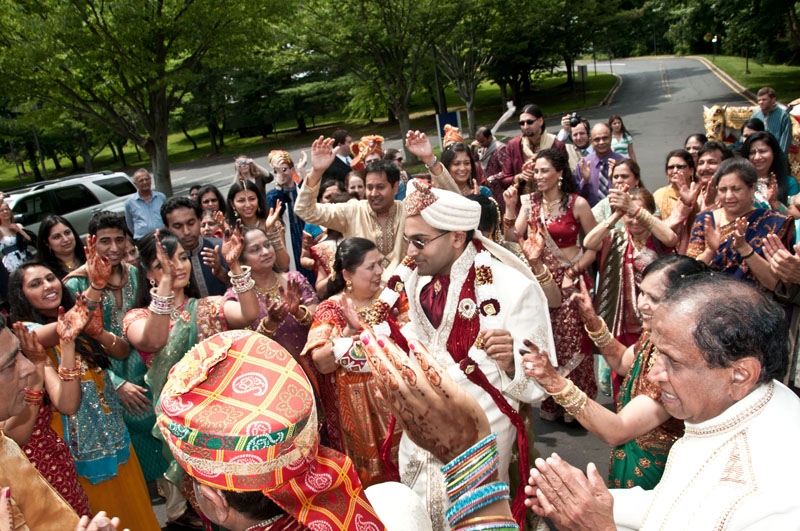
With so many cultures and rituals from different religions, an Indian marriage is anything but straight from the book. First and foremost, expect each state, each religion and each culture to have its own take on ‘The big Indian wedding’. However, the generalized term of the ‘Indian wedding’ is mainly associated with the Hindu marriage ceremony - an elaborate celebration lasting for several days. Most of the weddings rituals are based on their regional traditions but the common tie amongst the weddings of all the religions is the fun and excitement part.
Indian weddings are like big family meets. They are the big reason families get together, more so in states such as New Jersey (with larger Indian populations) in the US. It does not matter how expensive the travel becomes, but visas permitting, the aunt from Bangalore, the Uncle from Delhi and the great-aunt all the way from Punjab will definitely come, dressed in all their finery, to attend the wedding.
The Hindu marriage is held in a big marquee, either in the bride's home yard or in a rented wedding hall. Rituals are traditional in a Hindu wedding ceremony, but they may vary from one community to another. Different rituals are also held before the main wedding day – Mehandi being one such example. Ganesha puja (the cute little Elephant god; also known as the remover of obstacles), which is done before the ceremony for his blessings is another example. Than there are rituals like Tilak (the sacred mark on forehead), sangeet (song and dance), baaraat (procession), jai mala (garland exchange), vivah (the main wedding ceremony), kanya daan and vidaii, which are the most important Hindu wedding rituals.
The Indian Muslim wedding is celebrated with equal pomp and gaiety. They have various pre-wedding, wedding and post-wedding rituals. Each ritual has an important significance. In the pre wedding rituals the Mehandi ceremony is an important function. It is mostly celebrated at the bride's home on the eve of the wedding ceremony or a few days before the wedding. The function of Mehandi is celebrated in a traditional way where mostly female relatives and friends of the bride come to put turmeric paste on the bride (turmeric powder is an astringent and is supposed to bring a natural glow to the skin), and sing traditional marriage song and dance together.
Welcoming the baaraat (the arrival of the groom at the wedding venue) is one of the biggest functions on the wedding day. Expect to see grooms come in on horses, camels, elephants, chariots, limousines and today, even helicopters! In a Muslim wedding, the main ritual on the wedding day is the ‘Nikaah’ or the wedding ceremony. It is held either at the home of the bride or at any other common venue. The wedding is usually held in the presence of a priest, close family members, relatives and friends. The wedding is then registered in a document called the ‘Nikaahnama’. An elaborate dinner is set to celebrate the occasion.
In the post wedding rituals, ‘rukshat’ is when the bride's family bids farewell to her as she starts a new journey at her husband's house. Among the other post wedding rituals are ‘chauthi’ and ‘valimah’. In ‘chauthi’ the bride visits her parents home on the fourth day after the wedding (chautha means four). And ‘valimah’ is a kind of reception party where the family members and friends of the bride and groom come together to celebrate the occasion and bless the newly wed couple.
India has a huge Christian population as well (thanks to the Portuguese who made their way to Goa, India), making their weddings a part of the Indian wedding scene as well. The Christian wedding rituals are simple and charming. The wedding ceremony is conducted in the church. On the day of the wedding the best man greets the bride with a bouquet. The best man is someone very close to the bridegroom. She is then accompanied by her father to the altar. In the presence of two witnesses from both sides the bride and the groom declare themselves to be husband and wife. The groom declares his wedding vows. The couple exchanges their rings and the priest blesses the newly wedded couple and declares them husband and wife and than the groom seals their vows with a kiss for his newly wedded bride. After that the couple walk down the aisle together. Everyone then join the couple for the reception party. Here, the wedding cake is cut, and everyone raises the toast in the name of the bride and the groom. Expect to see the Christian bride dressed in a white saree in many cases – this is where the Indian influence comes in.
Similarly Sikh marriages also involve different rituals and customs. The Sikh marriages are festive family event. The ‘Reht Maryada’, which is the official Sikh code of conduct, specifies certain guidelines that as long as both the boy and girl profess the Sikh faith and no other faith they are joined in wedlock by the ‘Anand Karaj’ ceremony. The guidelines strictly forbid any sort of dowry system, astrology and any other superstitions associated with wedding date or time. Different rituals are associated with the Sikh marriages, which are performed on different days. Sikh marriages are also very common in the US, especially in NJ, NY and CA.
In India a large part of Parsi community still exists so Parsi marriages are also quite famous in India, especially in Bombay. In a Parsi marriage the gathering on the marriage day is called ‘Shahjan’, it is known as the gathering for the queenly bride. The bridegroom comes first to take the seat in the room where the marriage is to be celebrated. The bride comes later. The bridegroom sits on the right hand side of the bride, because it is considered as the place of respect. Both the bride and groom bring their close relatives as marriage witnesses. With the recital of the ‘Tan- dorosti’ prayer the wedding ceremony ends.
Indian weddings reflect the true color and traditions of India in a unique way. Add to that the slice of inter-faith and inter-cultural weddings and you have got yourself a fabric of varied textures and colors.
Thanks to Anika Sharma, contributing writer for NJWedding.com on South Asian weddings
Photo: Hot Shot Foto, East Brunswick, NJ
|
|
Added By: | |

|
NJWedding.com Wedding Services Belle Mead, NJ 08502 US |
| View Profile » Contact » | |
